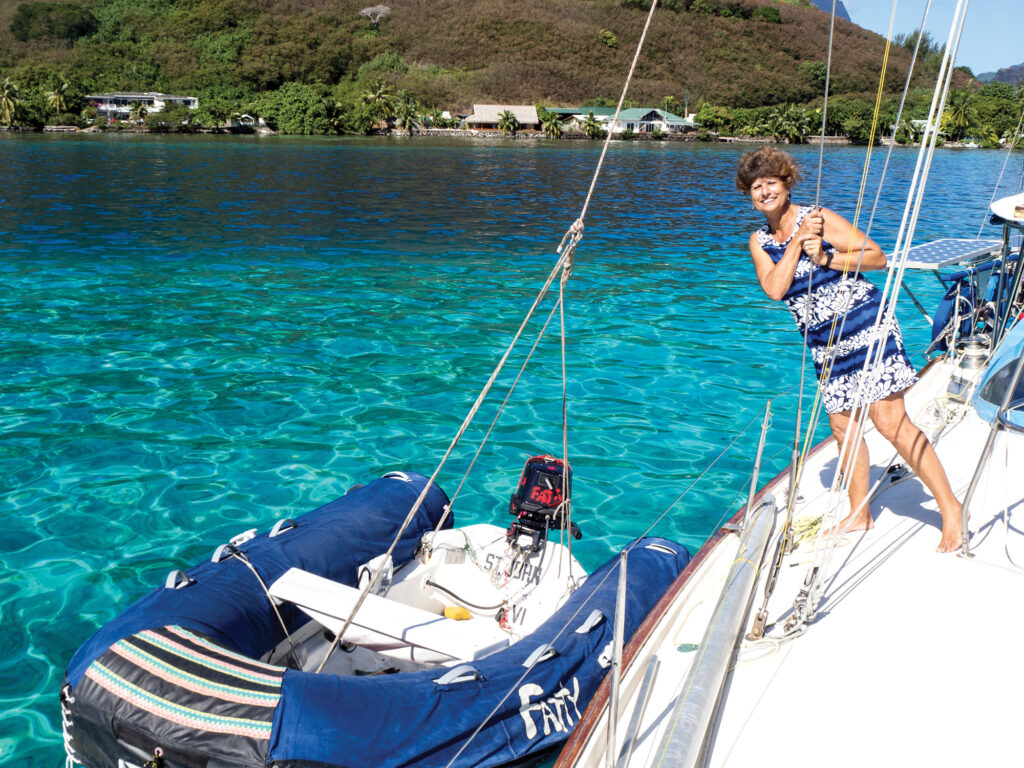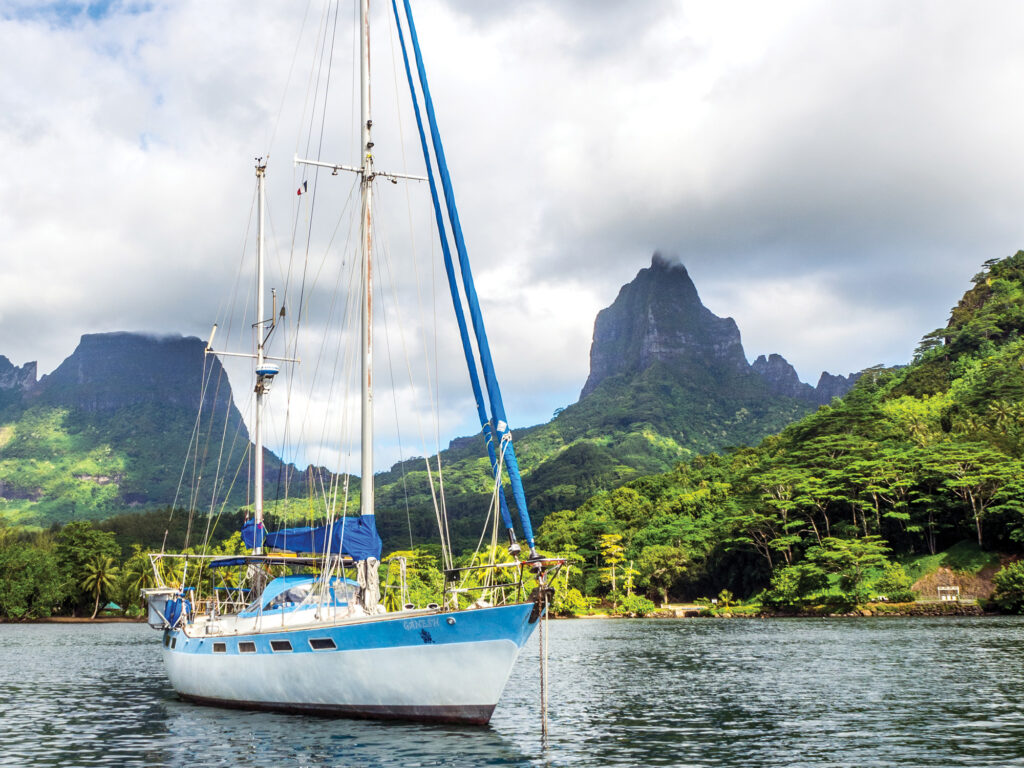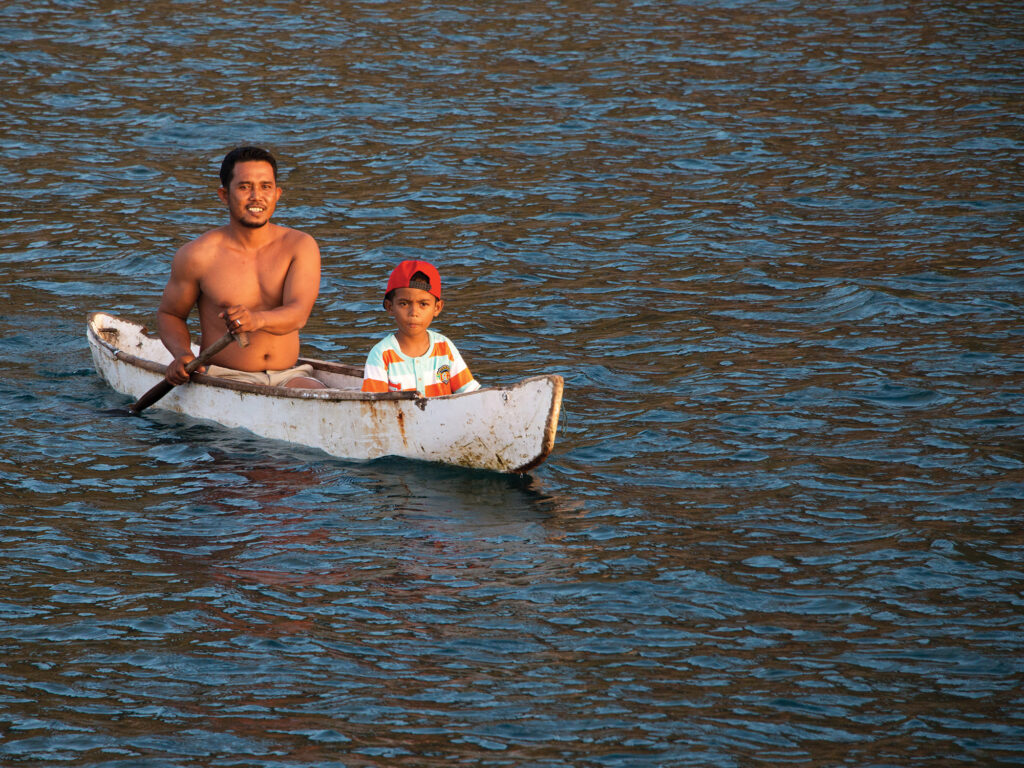
Of the 62 years I’ve lived aboard—52 of them with my wife, Carolyn—the vast majority of our time has been spent laying on our own hooks. Occasionally we’re required to pick up a mooring, but rarely do we go to a dock. Our record is two and a half years without touching a dock in the Caribbean; currently, while in Singapore, we’ve been 24 months without using our fenders. The longest we’ve stayed at a dock was five months in 2010 in Turkey; before that, I can’t even remember.
Why?
We like the privacy. Like kings of yore, we feel more at ease with a large moat surrounding our residence. I write a minimum of four hours a day, and there are fewer interruptions on the hook. We don’t end up with any stowaways. Rats are a real problem in the developing nations, as are roaches, termites and ants. Theft is much less of a problem. Ditto, marine salesmen, government officials and waterborne Jehovah’s Witnesses (who have managed to visit us twice!). The boat pivots into the wind. Swimming is merely a matter of falling in. Our cockpit meals are romantic, intimate affairs, and afterward, we can’t be charged with a credit-card reader. And best of all, living on the hook is almost always free—free in terms of money, yes, but also free of the hassles that marina life invariably includes.
Does this require special equipment? Yes, you need, in particular, the right attitude. We don’t live aboard because it’s easy. It’s not. It is wonderful (in part because it isn’t easy). Ease is a false god. Living aboard, the way we do it, is labor-intensive. But we’re happy to pay that price for the amazing, astounding personal freedom we enjoy year-round in the farthest corners of the globe.
Yes, at 70 we still have manual sheet winches; no, we don’t pay for a gym membership.
We believe that the entire world is a gourmet feast, and our vessel gives us the widest possible menu. We anchor somewhere exotic for as long as that destination offers us the highest-quality life imaginable, and when it ceases
to, we move on.
Currently we’re headquartering out of Singapore, with stunning Indonesia, diverse Malaysia and breathtaking Thailand a short sail away. Since our winds here are monsoonal, not trades, we can sail downwind to the Nicobars, India, the Maldives, Chagos, Oman, Yemen and the Horn of Africa, and then wait a month or two and toddle back to Singapore, also downwind!
How cool is that?
Obviously, our dinghy is extremely important, and everything about it is carefully considered. We use a 10-foot Caribe RIB. Our last one, under heavy use, lasted us 12 years because we treated it kindly and Carolyn made it a new sun cover every five to seven years.
Our RIB is powered by a lightweight and powerful 10 hp
Tohatsu outboard, supplied by a 3-gallon tank. This allows us to plane with two people, a bag of groceries, and a carton of beer—a good universal weight standard for yachties. The Tohatsu burns little fuel if we don’t run it wide open.
Not only is the dinghy our way of getting ashore and enjoying our cruising destination, but it also serves as a truck to bring our folding bikes ashore and to transport our propane, water, fuel tanks, and more. It also serves as our sports car and tour bus. We’ve met many wonderful locals far up rivers, in mangrove sloughs, and across shallow bays.
In place of an expensive outboard tiller extension, we use a properly sized piece of PVC pipe with an extended dead-man cable so I can stand up as I carefully weave through coral-strewn waters. (In St. Martin, someone gave us an expensive outboard tiller extension; it lasted an hour before being stolen.)
Our dinghy painters are always made from 3/8-inch yellow poly because it floats and, thus, avoids our prop while backing in reverse. We never allow our dinghy to stay in the water overnight. Instead, we hoist it on our davits, on the hip against the hull, or put it on deck. We never intentionally tow it offshore. Thus, during our last four circs, we’ve never lost or damaged our tender. (If, for some reason, you must tow a dinghy offshore in brisk conditions, string a short nylon rope with a fender off its transom so it doesn’t surf off.)
One more factor to consider with regard to our dinghy: We often use it to help others in distress. And because of that, we want it to be 100 percent ready at all times because we might need to instantly engage in highly dangerous activities with it: perform a rescue, tow a boat, chase away a bad guy, help another vessel kedge off.

Equal in importance to our dinghy is our ground tackle. Our primary anchor is a Rocna 55-pounder on 240 feet of 10 mm galvanized chain. While this works 90 percent of the time, it’s being ready for the other 10 percent that separates the men from the boys. We have a Viking 60 aluminum Danforth-style anchor and a 44-pound stainless-steel Bruce on deck as well, each with its own nylon rode. We employ these regularly as a second and third anchor, and contend that if you’re too lazy to do this, it is best to keep hugging the dock.
Since we’re now in our 70s, our windlass is quite dear to us. While we circumnavigated twice without one when Carolyn was a hot-hot chick, now we simply don’t have the muscles or endurance that we had when we were half our age.
The windlass, of course, hauls up our anchor, but it does far more. For instance, whenever a lubber anchors too close, it allows us to just smile and move. And if 10 minutes later, a lubberly friend of that lubber anchors too close, we move again. We never stand on our rights because our experience is that inconsiderate people don’t last long in the marine community, and besides, life is too short to deal with such folks. We’re sailors. We can sail away, and often do.
Occasionally we use our windlass to haul cargo such as water or 40-liter fuel jugs aboard using a bridle. Once we even used it to lift a quadriplegic friend aboard because they wanted to go for a sail. When we loaded our M92B Perkins diesel aboard, we hoisted and lowered it into place via our main boom, with trusty Carolyn at the windlass foot switch. I laughed at the estimate the yard gave me to hoist it aboard by crane.
Another tool in our quiver is our stout twin spinnaker poles. If there’s an annoying swell in the harbor, we use them to deploy our twin triangular flopper stoppers, while at the same time we sheet in our flat-cut, fully battened mizzen to smooth things out.
Needless to say, we select our anchorages carefully. Often we’re anchored in completely safe harbors. But there are times when we’re not. Occasionally we might just drop the hook in the lee, and during these times, we are always ready, 24/7, to go to sea.
Numerous times we’ve left the harbor at dusk and gone offshore to heave to as a blow approaches, much to the amusement of our less knowledgeable, more dock-trusting friends. Recently we and another boat did so, while seven cruising boats that didn’t ended up on the beach. Oops. Each of those skippers claimed it was a freak storm, but it wasn’t. It was just a capful of wind from the opposite direction, and totally predictable because a singlehander named Ross, on a British twin-keeler, and I read it correctly.
We had no watermaker for our first two circumnavigations, but on Ganesh, our 43-foot French ketch, we have a small desalinator that we use to make 3 gallons per day. We also have three levels of on-deck rain-catchment systems, similar to what we used one time when we stayed in deserted Chagos for four months.
Jugs play an important part in our life because we’re often lugging fuel from cheap gas stations instead of expensive marina pumps. Ditto for filling water tanks because we often use them to replenish water in one of our five separate tanks, designed so that if we get contaminated water, it doesn’t ruin our good water already aboard.
Batteries play a role in our ability to stay land-free as well. We have eight 6-volt Trojans in our house bank and four in our cranking bank, and they’re recharged by nine solar cells. Overkill? It sure is (intentionally) on sunny days in the tropics, but not on rough fall passages in the North Atlantic. We try to never crank up to charge, and haven’t in the past five or six years, anyway.

Do we wear foul-weather jackets that cost more than 10 times the price of our first liveaboard cruising vessel? No, we wear PVC stuff and buy it from where commercial fishermen shop. For us, it’s both the best value and the driest. (Yes, we replace our cheap PVC foulies every two decades or so—why not?)
Unlike others, satphones are not for us. To communicate, we use our VHF and SSB radios in conjunction with a Pactor modem to send off our stories and book manuscripts. Though in Singapore, we do have to carry mobile phones to use TraceTogether to reduce COVID-19 transmission, something we’re happy to do despite this being the first time I’ve ever owned a mobile phone. (I haven’t given anyone the number except for my wife and daughter. Why would I possibly want a device that could interrupt my dinner?)
A few other liveaboard tidbits to consider: While we never lock our boat in densely populated Singapore—we know these 6 million folks are honest—we do lock and alarm her in other areas. To do it, we’ve cobbled together a burglar and bilge alarm for 20 bucks that not only rings loudly and lights up the deck, but it triggers our masthead and spreader lights as well. And though we also lock our dinghy in certain anchorages, in others we don’t bother because both the RIB and outboard are clearly painted and marked in unusual ways, which is one of the reasons they are often passed over by lazy “teefs.”
We never leave anything valuable on deck. Ashore, we dress modestly and don’t wear flashy jewelry. If possible, we use inland ATMs. A few of the ATMs closest to the dinghy docks in Thailand are known to sport skimmers, which can capture your login info. We also carry five to seven debit cards from issuers in the United States, New Zealand and Southeast Asia so they can’t all be shut off at once in case of civil war, revolution, insurrection or natural disaster.
The result is two happy, healthy and loving people, smitten not only with each other, but the entire kooky world as well. And we do it all while living on the hook.
While Cap’n Fatty Goodlander frets about being anchor-bound for too long in Singapore, his wife, Carolyn, turns lemons into lemonade by studying Mandarin.








